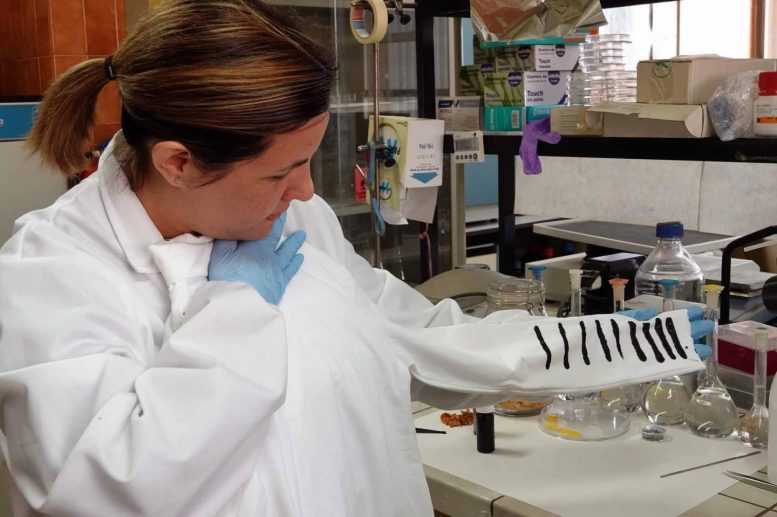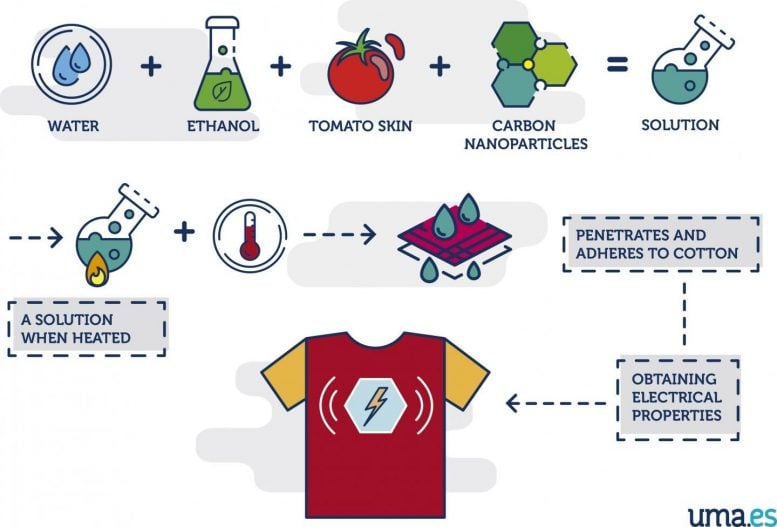Κινέζοι ερευνητές ανακοίνωσαν ότι δημιούργησαν ένα «έξυπνο» καινοτόμο ύφασμα, που ανακλά μακριά τη θερμότητα και μπορεί να μειώσει τη θερμοκρασία του σώματος κατά σχεδόν 5 βαθμούς Κελσίου.
Το λεγόμενο «μετα-ύφασμα», το οποίο μοιάζει με απλή κοντομάνικη μπλούζα (T-shirt), θα μπορούσε, αν παραχθεί μαζικά, να βοηθήσει τους ανθρώπους να προστατευθούν από την ολοένα μεγαλύτερη ζέστη, λόγω της κλιματικής αλλαγής, αναφέρει το ΑΠΕ.
Ο ρόλος των χρωμάτων στα ρούχα και η ζέστη
Για να μειώσουν την απορρόφηση της ηλιακής ακτινοβολίας, οι σχεδιαστές ρούχων συνήθως χρησιμοποιούν ανοικτά χρώματα στα υφάσματα. Μια άλλη μέθοδος είναι να ανακλάται η ηλιακή ηλεκτρομαγνητική ακτινοβολία, τόσο η υπεριώδης (UV) όσο και η εγγύς υπέρυθρη (NIR).
Η τελευταία θερμαίνει τα αντικείμενα που την απορροφούν και μετά αυτά αργά ψύχονται, καθώς σταδιακά την εκπέμπουν πίσω στο περιβάλλον. Ένα μειονέκτημα είναι ότι μετά την εκπομπή της από ένα αντικείμενο, η εγγύς υπέρυθρη ακτινοβολία συχνά απορροφάται από τα μόρια νερού της ατμόσφαιρας, με συνέπεια να ζεσταίνει τον γύρω αέρα.
Μια καλύτερη λύση είναι η ακτινοβολία στο μέσο υπέρυθρο φάσμα (MIR), που έχει μεγαλύτερο μήκος κύματος και δεν απορροφάται από τα μόρια του περιβάλλοντος αέρα, αλλά φεύγει απευθείας στο διάστημα, με αποτέλεσμα να ψύχονται τόσο τα ίδια τα αντικείμενα όσο και ο αέρας γύρω τους. Το ανθρώπινο δέρμα, αντίθετα με τα ρούχα, εκπέμπει MIR. Οι Κινέζοι ερευνητές του Πανεπιστημίου Επιστήμης και Τεχνολογίας της Χουατσόνγκ, οι οποίοι έκαναν τη σχετική δημοσίευση στο περιοδικό “Science”, σύμφωνα με το ίδιο και το “New Scientist”, σχεδίασαν το πρώτο ύφασμα που επιτρέπει στη μεσαία υπέρυθρη ακτινοβολία MIR, η οποία εκπέμπεται από το δέρμα, να διαπερνά εύκολα το ρούχο. Για να είναι πραγματικά αποτελεσματικό, το νέο ύφασμα πρέπει να εφάπτεται στο δέρμα. Το μετα-ύφασμα που μπορεί να βαφτεί σε διάφορα χρώματα και είναι φτιαγμένο από πολυλακτικό οξύ, συνθετικές ίνες Τεφλόν και νανοσωματίδια από διοξείδιο του τιτανίου (που υπάρχουν και στα αντηλιακά), ανακλά επίσης στο διάστημα την υπεριώδη ακτινοβολία, την ορατή και την εγγύς υπέρυθρη, πράγμα που επιτρέπει τη μεγαλύτερη μείωση της θερμοκρασίας του σώματος.
Πειράματα έδειξαν ότι όταν με ένα κανονικό βαμβακερό ρούχο η θερμοκρασία του δέρματος είναι γύρω στους 37 βαθμούς, με το νέο ύφασμα πέφτει στους 31 έως 32. Σε άλλο πείραμα με αυτοκίνητα, ένα από τα οποία καλύφθηκε με το μετα-ύφασμα, ένα δεύτερο με ένα τυπικό κάλυμμα και ένα τρίτο έμεινε ακάλυπτο κάτω από τον ήλιο το μεσημέρι, η θερμοκρασία ήταν 60 βαθμοί Κελσίου στο τελευταίο, 57 βαθμοί στο δεύτερο, ενώ μόνο 30 στο πρώτο.
Αν και μοιάζει με κανονικό ρούχο, στην ουσία είναι ένα είδος καθρέφτη, σύμφωνα με τους Κινέζους ερευνητές, οι οποίοι ήδη αναζητούν εταιρείες κατασκευής υφασμάτων και ρούχων για να αξιοποιήσουν εμπορικά την εφεύρεση τους. Όπως εκτιμούν, η νέα τεχνολογία ανεβάζει μόνο κατά 10% το κόστος παραγωγής.
T-Shirt Generates Electricity From Body Temperature Difference to Surroundings

Researchers of the Faculty of Science of the University of Malaga (UMA) have designed a low-cost T-shirt that generates electricity from the temperature difference between the human body and the surroundings. Credit: University of Malaga
The ‘e-textile’ prototype uses sustainable and low-cost materials like tomato skin.
Researchers of the Faculty of Science of the University of Malaga (UMA) have designed a low-cost T-shirt that generates electricity from the temperature difference between the human body and the surroundings. We are talking about the “e-textile” prototype, developed in collaboration with the Italian Institute of Technology in Genoa (IIT) based on sustainable methods and low-cost materials like tomato skin.
“So far, metals have been the chemical elements commonly used in the fabrication of electronic devices. This project took a step forward, and we have been able to generate electricity by using light and more affordable and less toxic materials”, explains José Alejandro Heredia, one of the authors of this project.
The formula is very simple: water and ethanol -a type of ecological alcohol- derived from tomato skin and carbon nanoparticles. A solution that, according to experts, when heated, penetrates and adheres to cotton, thus obtaining electrical properties, like those generated by tellurium, germanium or lead, but from biodegradable materials.
“When someone walks or runs, warms up. If such person wore a T-shirt designed with these characteristics, the difference between his/her body and the colder temperature of the surroundings could generate electricity”, says Susana Guzmán, another author from the UMA.
“Iron Man” made in UMA
The results of this project, in which the Italian researcher Pietro Cataldi has participated, were published in the journal Advanced Functional Materials. At present, this group of scientists continues their work on the development of devices that can be incorporated into textile to be able to, for example, generate light to make this T-shirt reflective or even charge a mobile phone without a charger.

Researchers of the Faculty of Science of the University of Malaga (UMA) have designed a low-cost T-shirt that generates electricity from the temperature difference between the human body and the surroundings. Credit: University of Malaga
Other possible applications include biomedicine, thanks to the monitoring of signals of each user, or robotics, because the use of these lighter and more flexible materials enables improvement of robot features.
“In a previous study, we were able to create a Wi-Fi antenna from tomato skin and graphene. We are also studying the possibility of incorporating this invention into the “e-textile” T-shirt, which would enable us to be like the superhero Iron Man, who wears a suit with all types of technological devices, and even fly,” jokes Guzmán.
Reference: “Green Biocomposites for Thermoelectric Wearable Applications” by Pietro Cataldi, Marco Cassinelli, José A. Heredia‐Guerrero, Susana Guzman‐Puyol, Sara Naderizadeh, Athanassia Athanassiou and Mario Caironi, 28 October 2019, Advanced Functional Materials.
DOI: 10.1002/adfm.201907301
José Alejandro Heredia and Susana Guzmán are members of the Department of Molecular Biology and Biochemistry of the University of Málaga. They are part of the Institute for Mediterranean and Subtropical Horticulture (IHSM) and their main R+D+i lines include the fabrication of electronic devices with biodegradable materials.




0 Post a Comment:
إرسال تعليق